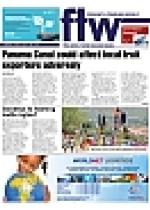Since signing its
memorandum of
understanding
(MoU) with
Transnet Freight Rail
(TFR) in late 2013,
Barloworld
Logistics has
made “a lot
of progress”,
particularly
around
intermodal
terminal
developments
– including
participation
in the tender
for the
Grootvlei
Coal
Terminal
near Balfour
in Mpumalanga.
“We are close to
concluding certain
developments, although we
are not ready to disclose
specific details yet,” said
Barloworld Logistics
marketing executive Kate
Stubbs. She told FTW that
the partnership was going
well – although there were
certain aspects that needed
to be ironed out – and that
the two entities had learnt
to work well with each
other.
“We have been fortunate
to continue to work
with the same team we
negotiated the deal with
and so we’ve had a lot of
policy and developmental
consistency,” Stubbs said.
According to her, there
are “pockets of excellence”
within TFR and this has
created good synergies.
“Our partnership mandate
is to build skills and
capacity,
invest in
assets –
including
managing
and
developing
intermodal
terminals
– and to
provide
innovative
technology
solutions
to improve
end-to-end
supply chain
visibility,” said Stubbs,
noting that Barloworld
Logistics had always
been more focused on
finding the right end-toend
solutions at the right
service and cost, regardless
of the mode of transport.
“We do have a large
f leet of vehicles but we’ve
never been road transportdriven
and we understand
the need for a land-based
intermodal solution that
best meets our customers’
needs for efficiency and
cost-effectiveness.”
That being said, Stubbs
noted that in some
cases rail, as part of an
intermodal solution, had
not proven to be the most
cost-effective solution,
nor the most operationally
efficient, in some cases.
“We have found that the
need for handling – loading
containers on and off
road to rail – has doubled,
tripled or even quadrupled.
This ups the logistics costs
and adds security and
cargo quality risks,” she
pointed out, adding that
these were some of the
challenges being ironed out
between the partners.
“It takes a lot of
negotiation between
private sector partners
(PSPs) and state-owned
enterprises to ensure
all needs are met, the
right changes are made
and proper capacity and
efficiency is built up. It is
not a quick solution, but
we are getting there,” said
Stubbs.
Some of the issues that
contribute to operational
inefficiencies and higher
costs include the fact
that the current rail
infrastructure is not as
f lexible as the road – but
Stubbs pointed out that
this was being addressed
through the development
of intermodal terminals.
“We are moving towards
a solution that sees road
transport being the first
and last leg of the journey
and rail transport being
used for the longer trip.”
While Stubbs said there
had been queries and
interest from clients for the
addition of rail as part of
the supply chain solution,
she acknowledged that it
was a challenge to convince
a number of customers
about the reliability of
rail and to prove the
intermodal business model
was a viable one. “There
is still a poor perception
out there about the
reliability and
capacity of rail
and we know
it will take
some time
for some
of our
customers to come round,”
she said.
Stubbs pointed to
TFR’s innovation in
addressing challenges as
one of the ways in which
customer perceptions
could be changed for the
better. “For example,
TFR has been developing
specialised containers
for bulk and general
cargo. This especially in
light of demand for
bulk commodity
transport
dropping as
the global
price slump
continues,” she
said.
INSERT & CAPTION
We are close to
concluding certain
developments,
although we are not
ready to disclose
specific details yet.
– Kate Stubbs
Rail still a hart sell - but innovation yields solutions
25 Mar 2016 - by Adele Mackenzie
0 Comments
FTW - 25 Mar 16

25 Mar 2016
25 Mar 2016
25 Mar 2016
25 Mar 2016
25 Mar 2016
25 Mar 2016
25 Mar 2016
25 Mar 2016
Border Beat
17 Jun 2025
30 May 2025
Poll
Featured Jobs
New
